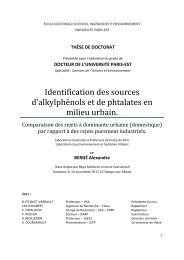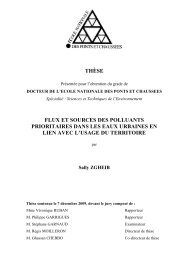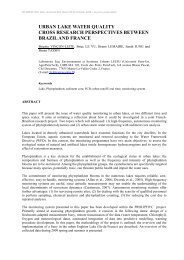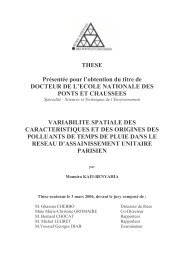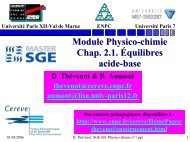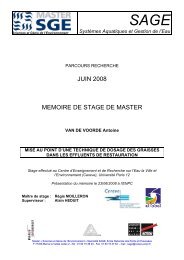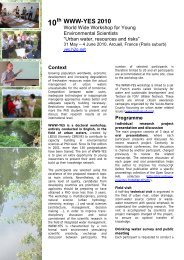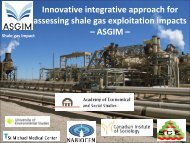View - ResearchGate
View - ResearchGate
View - ResearchGate
Create successful ePaper yourself
Turn your PDF publications into a flip-book with our unique Google optimized e-Paper software.
15 Urban wastewater reuse for irrigatedagriculture in Jordan: Soil sustainability,perceptions and managementG. Carr, S. Nortcliff and R.P. PotterSchool of Human and Environmental Sciences, University of Reading, Reading,Berkshire, UK (E-mail: g.carr@reading.ac.uk)AbstractJordan is a country with very limited water resources and urban treated domesticwastewater offers a valuable contribution to the country's water balance. Water reuseis particularly well-suited to irrigated agriculture, for which water is in constantdemand. The physical characteristics of the water (high organic content and soluteloaded) mean that suitable soil management strategies, such as periodic leaching andnutrient management are required to maintain soil productivity and prevent theaccumulation of plant toxic solutes. The effect of water reuse on soil sustainabilitywas investigated by means of soil sampling and analysis combined with interviewswith farmers and organisations involved with water reuse. The results reveal that theperception and knowledge of the water is important in the process of decision makingas to the relevant management strategy to be applied. The research stresses thatmaintaining soil sustainability when reusing water is imperative for agriculturaldevelopment in Jordan and achievable through water management both on and off thefarm.nitrogen, phosphorus and potassium. The strong psychological aversion to reallocating usedwater to domestic needs also drives the use of treated wastewater for irrigated agriculture.In Jordan water reuse is taking place on a grand scale. 65 per cent of households are connectedto a central sewage system (Water Authority of Jordan, 2007) which means that about 80million cubic metres (MCM) of wastewater are produced annually (Vallentin, 2006). Thisconstitutes just under 10 per cent of Jordan’s 850 MCM of renewable water annually. Themajority of this is produced at the Kirbet As Samra treatment plant located 30 km east ofAmman (the capital of Jordan). Figure 1 is a schematic diagram showing the domestic towaste to irrigation water pathways in north-west Jordan. It shows that the majority of thewastewater coming from Amman is sent to the Kirbet As Samra treatment plant. Aftertreatment the water is released to the Zarqa River, where it flows down to the King TalalReservoir. From the reservoir it is then released as required to be used for irrigation in theJordan Valley (a major agricultural area). The use of the water is split between that consumeddirectly around the treatment plant and that used indirectly (after significant transportation andthe seasonal addition of natural surface runoff) in the Jordan Valley.KeywordsPerception; sustainable development; urban water; water management; water re-useINTRODUCTIONWater scarcity is a growing problem across the world as greater pressure is placed on theavailable water resources. Rising populations require more freshwater for drinking, domesticuses and particularly for food production. Irrigated agriculture is essential to sustain theincreasing populations and in arid and semi-arid lands it commonly absorbs a majority share ofthe freshwater resources. The countries of the Middle East are facing some of the greatestwater shortage problems in the world. The available resources are significantly lower than thepotential demands placed on them by industry, agriculture, tourism and domestic uses. Jordan,at the centre of the Middle East, is one of the most water scarce countries of the world. Withonly 497 cubic metres per person per year (FAO Aquastats, 2008) it is well below the officialcriteria for water scarcity of 1000 cubic metres per person per year (Winpenny, 2000).There are three principle ways which water scarcity can be alleviated. Firstly, through thedevelopment of new resources through the construction of dams, desalination of sea water orby exploiting deep groundwater resources. Such schemes typically involve hard engineeringand technological developments and tend to be expensive. Secondly, through water demandmanagement which aims to lower the demand for water by encouraging water saving devicesand reducing water use in the home, in industry and in agriculture. Thirdly, by reusing urbandomestic wastewater after it has been treated. Treated wastewater is particularly well suitedfor agriculture as it often contains significant quantities of plant essential nutrients likeFigure 1 Schematic diagram and corresponding map of the water pathways in north-west JordanWater has been reused successfully in Jordan for several decades and the aim of this researchis to investigate the sustainability of this practice in terms of both the effects on soil and theability of people to manage and mitigate these effects. Water management is increasinglyemphasising the importance of an holistic and interdisciplinary approach to overcome thewater challenges of the 21 st century. The need to incorporate social considerations withtechnical planning is frequently discussed, yet in reality it is often limited or lacking. Thisresearch seeks to emphasise that combining research from the social and physical sciences isboth easily accessible and highly profitable in terms of research findings for watermanagement issues.METHODSTo reflect the interdisciplinary nature of the work several different research methodologiesWWW-YES 2008, Paris 13 – 16 May 2008 131WWW-YES 2008, Paris 13 – 16 May 2008 132



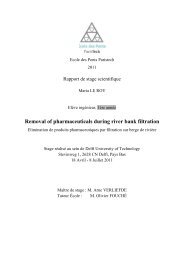
![[pastel-00730831, v1] Incidence des pratiques d'entretien ... - LEESU](https://img.yumpu.com/50938896/1/184x260/pastel-00730831-v1-incidence-des-pratiques-dentretien-leesu.jpg?quality=85)

